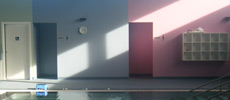Hydrotherapy
Hydrotherapy is when you can manage your exercises in the hydrotherapy pool independently and safely. You may use a laminated programme devised by our physiotherapist or other physiotherapists or it could be simply just walking in water on a doctor’s surgeon’s recommendation. Our pool also has massage spas which can complement your hydrotherapy session.
We have an on-site, modern purpose-built, warm (35-36 degrees Celsius), 11 X 7 metre pool, varying in depth from 1.2 to 1.5 metres, so enabling a large range of exercises to be performed.
Pool Design

The pool has shallow steps with rails to assist entrance and exit. There is also a rail all the way around the pool to allow a firm hand-hold if needed for exercise, or for non swimmers’ security. The pool has a “wet deck” to reduce wave formation and facilitate entrance and exit.
Spa Facility

In the shallow end of the pool there are six jet-adjustable spa seats, so there is no difficult climbing into the deep separate spa. This allows for muscle relaxation with the massage of the warm water jets.
Pool Equipment

We have a hoist for people who cannot use the pool steps.A variety of floats and buoyancy aids are available to be used to support, assist or resist movement.
Changing Rooms

There are three changing rooms, one female, one male, and one disabled (for people in wheelchairs, or where carers may assist if a client needs help with dressing). Each has its own toilet and shower facilities. There is also a poolside shower.
Benefits of Hydrotherapy

Hydrotherapy means ‘healing by water’.
Exercise in our Clarence hydrotherapy pool has particular benefits for joints and muscles by:
- Unloading of the weight of the body though the buoyancy of the water reduces stress on joints especially the lower back, hips knees and ankles.
- Heating The warmth of the water allows for less pain, relaxation and ‘letting go’ of postural muscles to allow for better movement where stiff.
- Compression of the skin with the pressure of the water, particularly when exercising, helps with return of fluid to the heart and reduces oedema.
- Smooth resistance of muscles graded to suit all levels of fitness and swimming ability by varying the speed of movement. Equipment and water depth selection may be used to help increase range of movement, resist movement for strength, to stimulate better balance or a combination of these effects.
- Practical function activities such as balance, walking, squatting and stepping exercises to be performed that may be too difficult to do otherwise. This hopefully will bridge the gap to improving land function too.
Treatment Procedures
It is usually best to have an assessment by our physiotherapist first to ascertain the extent of the problem and its limitations. Home exercises may also be of benefit and of course can be done more frequently. Advice may be given on how to better manage a condition, either to assist with healing, to try prevent recurrence, or to slow down progression.
Sometimes further treatment or hydrotherapy alone may be needed, or treatment may be combined with hydrotherapy to maximise its effect. For example, pre-pool joint mobilisation / exercise may be needed to allow for better movement in the pool or enable the progression of exercises without aggravation.
If safe and appropriate, an individual pool exercise programme may be prescribed to be continued in a group situation, without the need of a one-to-one physiotherapy session, so saving on costs. This is especially useful if it is found that “maintenance” exercises are necessary to control an ongoing problem.
A pool ‘treatment’ session may be described as Aquatic Physiotherapy or Treatment and is charged as a land session, whereas maintenance is described as Hydrotherapy and is charged at a lesser group rate—so benefiting people who are trying to manage chronic, or long term problems.
During the course of treatment it may be necessary to write to your doctor to inform him/her of your progress or outcome.
